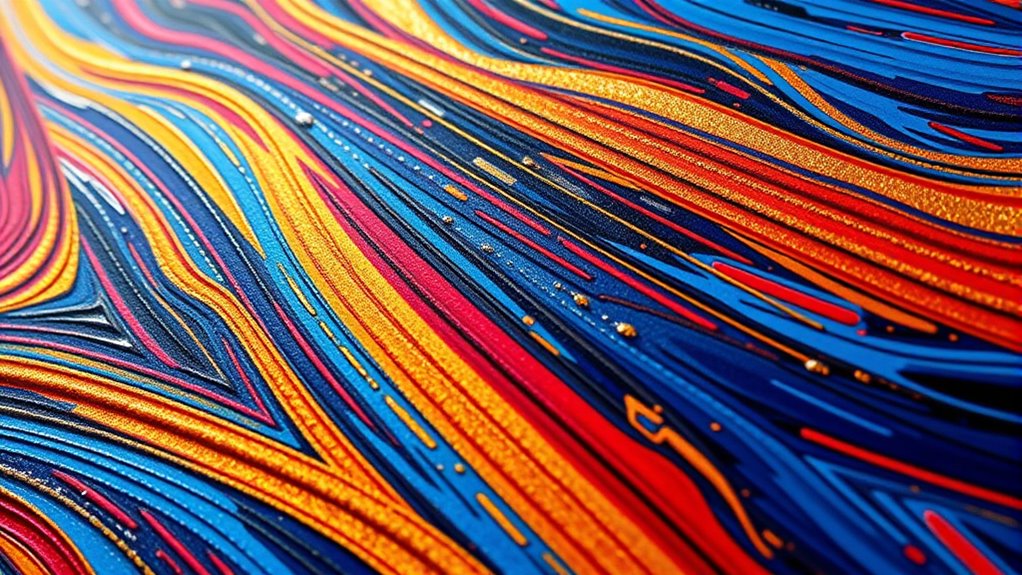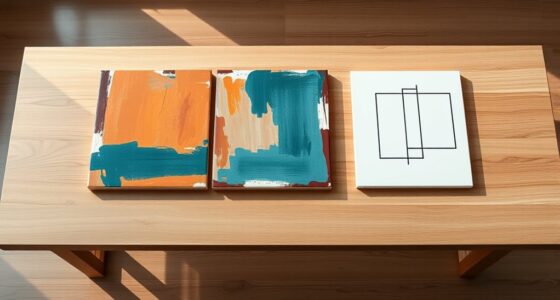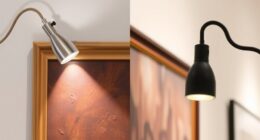To create linear texture effects with strié and dragging techniques, you’ll want to focus on controlled, deliberate brush movements. Use fine-tipped brushes or tools held at consistent angles, applying gentle, repeated strokes for strié, and smooth pulling motions for dragging. Managing your medium load and pressure helps blend textures seamlessly into backgrounds or foregrounds. Mastering these methods adds subtle movement and surface depth to your work—continue exploring, and you’ll discover how to elevate your art with these tactile effects.
Key Takeaways
- Strié creates fine, parallel lines for subtle linear textures, emphasizing movement and surface detail.
- Dragging involves pulling mediums across surfaces to blend colors and form smooth, linear transitions.
- Both techniques require precise brush control, steady pressure, and deliberate movements for uniform effects.
- Mastering these methods enhances surface texture, adding depth, tactile quality, and elegant linear elements.
- Practicing strié and dragging improves control over medium application, resulting in sophisticated linear texture effects.

Have you ever noticed the subtle textures created by strié and dragging techniques in art and design? These methods add a refined, linear quality to your work, giving surfaces a tactile, almost woven appearance. To achieve this, you’ll want to focus on mastering specific brush techniques that allow for controlled, deliberate strokes. Strié involves creating fine, parallel lines that can evoke a sense of movement or texture, while dragging emphasizes pulling paint or medium across a surface to blend or stretch colors into sleek, linear patterns. Both techniques rely heavily on your brushwork and how you manipulate your tools to produce consistent, intentional effects.
Master subtle textures with controlled strié and dragging techniques for refined, linear surface effects.
When working with these effects, your brush techniques are essential. For strié, you’ll typically use a fine-tipped brush or a flat brush held at a consistent angle, applying gentle, repeated strokes in one direction. The key is maintaining steady pressure and movement to create uniform lines that follow your intended flow. Dragging, on the other hand, involves pulling your brush or tool across the surface with a measured, smooth motion. This can be done with a brush, palette knife, or even a cloth, depending on the desired texture. The goal is to stretch and blend the medium seamlessly, creating a linear texture that appears integrated into the surface rather than layered on top.
Controlling the medium load on your brush is crucial for achieving consistent texture effects. Texture blending plays a critical role in these techniques. By carefully controlling how much medium you load onto your brush and how you manipulate it, you can seamlessly blend textures into the background or foreground of your piece. For example, dragging can help smooth transitions between colors, producing a gradient effect that enhances the linear quality of the texture. With strié, you can build up layers of parallel lines, adding depth and complexity without overwhelming the composition. As you develop your skills, you’ll learn to adjust your pressure, speed, and angle to fine-tune the texture blending, resulting in a harmonious integration of linear textures within your artwork.
Practicing these brush techniques will also improve your control over the medium, whether you’re working with oil, acrylic, or digital tools. The more you experiment with texture blending through strié and dragging, the more intuitive your movements will become. As a result, you’ll be able to incorporate subtle, linear textures effortlessly into your projects, adding a sophisticated dimension to your designs. Remember, patience and deliberate practice are essential. With time, you’ll master how to create precise, elegant textures that elevate your art and give your work a unique, tactile quality.
Frequently Asked Questions
Can Strié and Dragging Techniques Be Combined With Other Texture Effects?
Yes, you can combine strié and dragging techniques with other texture effects. By using blending techniques, you seamlessly integrate different textures, creating a richer, more complex surface. Layer integration helps you control how these effects interact, allowing you to build depth and variation. Experimenting with these methods lets you achieve unique visual results, making your textures more dynamic and realistic while maintaining control over the overall composition.
What Tools Are Best for Achieving Precise Linear Textures?
You should choose brushes with fine, tapered tips for precise linear textures. Focus on tools that give you excellent stroke control, like custom brushes or those with adjustable settings. Using a stylus or graphics tablet enhances accuracy, allowing you to create clean, consistent lines. Adjust brush size and spacing for better control, and experiment with pressure sensitivity to vary line thickness, ensuring your linear textures are sharp and well-defined.
How Do Lighting Conditions Affect the Appearance of These Textures?
Lighting conditions considerably impact how linear textures appear. The light source impacts the visibility of the strokes, making them more pronounced or subtle depending on its angle. Surface reflectivity also plays a role; a highly reflective surface will catch more light, emphasizing the texture, while matte surfaces diffuse light, reducing contrast. Adjusting your lighting setup helps control the texture’s appearance, ensuring it aligns with your artistic vision.
Are There Digital Software Options for Creating Strié and Dragging Effects?
Yes, you can definitely develop striking strié and dragging effects using digital brushes and texture overlays. Many software options like Photoshop, Krita, and Procreate offer specialized brushes that mimic these linear textures, making your work more manageable. You simply select the right brush, layer texture overlays, and slide, swipe, or streak to achieve the desired linear effects, transforming your digital drawings into dynamic, textured masterpieces with ease and efficiency.
What Are Common Mistakes to Avoid When Applying These Techniques?
When applying these techniques, avoid inconsistent brush consistency, which can lead to uneven textures. Make sure to maintain steady stroke direction; changing it abruptly can break the smoothness of the effect. Also, practice control over your brush pressure to prevent overly bold or faint lines. Keep your strokes deliberate and consistent, and regularly check your work from a distance to catch any irregularities early.
Conclusion
Now that you’ve mastered strié and dragging, your paintings will burst with textures so vivid, they practically leap off the canvas! Imagine sweeping your brush and releasing waves of lines so dramatic, they could slice through the air or shake the ground beneath your viewers’ feet. With these techniques, your artwork transforms into a powerful force of nature—an unstoppable storm of movement and energy that leaves everyone breathless and craving more.









